A Few Unconventional Moves…..If I am to talk about some unconventional things that I did at my backstrap loom this week, I think that I would have to first define what is meant by “conventional” in the world of backstrap weaving….an impossible task!
What is normal, or traditional, or conventional in one backstrap weaving community may not be so on the other side of the world or even within the same region or country.
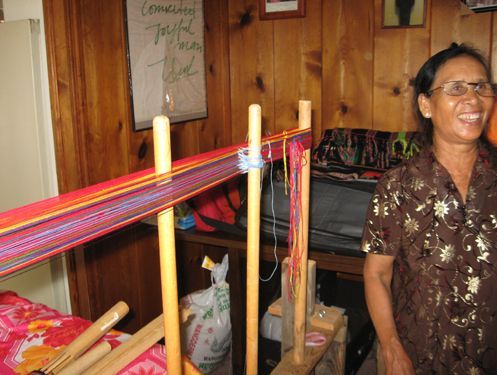 Adding string heddles as one winds the warp, as Montagnard weaver Ju Nie does, would certainly be looked upon with wonder as something strange and unusual by backstrap weavers here in Bolivia.
Adding string heddles as one winds the warp, as Montagnard weaver Ju Nie does, would certainly be looked upon with wonder as something strange and unusual by backstrap weavers here in Bolivia.
The way that many backstrap weavers in Ecuador spread the threads in the shed rod shed over two shed rods is something that I have not seen outside of Ecuador. This makes opening the shed rod shed, with its heavy load of wool warps, easier. You can see the two shed rods in Miguel Andrango’s warp above. Unconventional, you might say, but to weavers like Miguel Andrango, this is perfectly normal. And Mr Andrango is up for a bit “unconventionality” in his weaving too by using motifs that are not traditional in Otavalan weaving.
 The use of a tiny sweet wooden temple on even the narrowest of warps by the Montagnard backstrap weavers is something else that would seem less than normal to many backstrap weavers on this side of the world.
The use of a tiny sweet wooden temple on even the narrowest of warps by the Montagnard backstrap weavers is something else that would seem less than normal to many backstrap weavers on this side of the world.
I have yet to see a circular warp being used by backstrap weavers in Bolivia but it is commonplace in Ecuador as is the use of a foot brace.
Burmese weaver Dar Ku weaves her patterns with supplementary weft while facing the wrong side of the cloth. She kept smiling and telling me how easy it is. I wonder what the Guatemalan weavers with whom I have worked, who also work with supplementary wefts, would think of that!

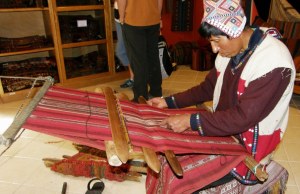 In Ecuador I never saw women weaving wide heavy wool pieces on backstrap looms. This was a task for men. The work is considered too heavy for women, I was told.
In Ecuador I never saw women weaving wide heavy wool pieces on backstrap looms. This was a task for men. The work is considered too heavy for women, I was told.
In Peru, men do weave at backstrap looms and there are communities where most of the backstrap weaving is in their hands. However, this is the exception rather than the rule.
I wonder what the male Ecuadorian weavers would think coming to Peru and seeing the wide and heavy warps being managed by the female weavers.
I wonder what the belt weavers in Salasaca, who use an enormous meat cleaver type of wooden implement to beat weft into place on their narrow belts with a couple of quick, heavy and powerful slams, would think seeing the way a Bolivian weaver pushes weft firmly into place bit by bit across the wdith of the warp with the tip of a llama bone tool.
 All the implements were strange and unusual in my hands the first time. I can’t tell you how many times I forgot to let go of the weft before slamming that meat cleaver tool down….ouch. The llama bone was a bit more subtle but I still ended up with blisters from tightly clenching it and pushing that weft into place with all my strength. My weaving teachers considered tightness of weave to be a very important feature of well made cloth and I was determined to achieve their approval.
All the implements were strange and unusual in my hands the first time. I can’t tell you how many times I forgot to let go of the weft before slamming that meat cleaver tool down….ouch. The llama bone was a bit more subtle but I still ended up with blisters from tightly clenching it and pushing that weft into place with all my strength. My weaving teachers considered tightness of weave to be a very important feature of well made cloth and I was determined to achieve their approval.
On the other hand, it was interesting to watch the gentle tappy-tapping of the beater in Dar Ku’s hands in contrast to the yell of “wham-wham” as Ju Nie showed us how firmly weft should be beaten! Clearly there is no general rule about how firm warp-faced cloth woven on a backstrap loom should feel.
I would love to see my teacher Maxima’s reaction to the set-up and way that weavers in coastal Ecuador add bands to the edges of their fabrics with their wooden rigid heddle that slides from side to sde along the floor to change sheds.
 So…conventional? What is conventional in the world of backstrap weaving?
So…conventional? What is conventional in the world of backstrap weaving?
As for my aforementioned “unconventional” moves…let’s just say that I did some things that I haven’t seen backstrap weavers do. Of course, the day will probably come when I see this done somewhere. I have, after all, just scratched the surface of the backstrap weaving world here in Latin America and have had but the slightest glimpse into Montagnard, Burmese and Bhutanese weaving.
I have been finishing off the little supplementary-weft sampler that I have been working on these last couple of weeks. I wanted to get a piece off the loom and make it into a bag to take along on my next trip. I had experimented with positive and negative space. However, there was still a fair amount of warp left and the Guatemalan cotton is precious to me as I am not sure when or if I will be able to get more. I really didn’t want to waste any of it.
So here is what I did…I wove a dowel into the warp so that I could cut off my little bag piece and continue weaving the left over warp.
 I will probably fold that little flap of cloth over the dowel and tack it down and then lash the dowel to a bigger one. I think that should be sturdy enough to allow me to keep weaving. I have to admit that this wasn’t my idea. There was a discussion in one of the online groups where a floor loom weaver wanted to cut off her first towel on a long warp and then continue weaving. Someone said “weave in a dowel”. I am not sure if what I did is in fact what she meant when she said that but it was enough to have me wanting to try to “weave in a dowel”. I think it will work!
I will probably fold that little flap of cloth over the dowel and tack it down and then lash the dowel to a bigger one. I think that should be sturdy enough to allow me to keep weaving. I have to admit that this wasn’t my idea. There was a discussion in one of the online groups where a floor loom weaver wanted to cut off her first towel on a long warp and then continue weaving. Someone said “weave in a dowel”. I am not sure if what I did is in fact what she meant when she said that but it was enough to have me wanting to try to “weave in a dowel”. I think it will work!
 I still have this Bedouin patterned embedded double weave piece that I cut and then clamped so that I could continue working on it. It is still there….I feel that that the woven-in dowel is a more secure system. We will see. Now I can compare!
I still have this Bedouin patterned embedded double weave piece that I cut and then clamped so that I could continue working on it. It is still there….I feel that that the woven-in dowel is a more secure system. We will see. Now I can compare!
 Here is the wee pouch that I made with the first part of that warp.
Here is the wee pouch that I made with the first part of that warp.
So, the piece of supplementary-weft patterned fabric was cut off the loom. Now to see how best to fold it.
 There are the back and front views. I decided to leave the flap on the front unpatterned as I wanted to edge the whole thing with a tubular band and I thought that things might look a bit too busy with pattern on the flap as well.
There are the back and front views. I decided to leave the flap on the front unpatterned as I wanted to edge the whole thing with a tubular band and I thought that things might look a bit too busy with pattern on the flap as well.
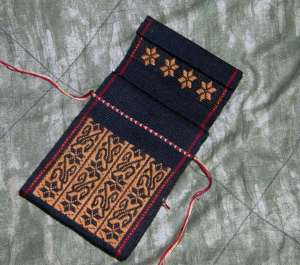 However, I thought that it would be cute to have a design on the inside when the flap is open.
However, I thought that it would be cute to have a design on the inside when the flap is open.
And that is another place where I got kind of unconventional.
The design on the inside of the flap had to be on the “wrong” face of the fabric to be in the right position once everything was folded. So, I turned the warp over and wove on the other side leaving the heddles on the back side of the fabric.
I wove the flower head pattern that I had been creating in the negative space at the beginning of the piece. I think it gives a nice touch to this little pouch…a nice little surprise when you open it up.
 Folding and then sewing done…it was time to start embellishing.
Folding and then sewing done…it was time to start embellishing.
 This is all I have done so far… a ñawi awapa tubular band around the outside. The eyes of the tubular band are red on the back side which matches the predominantly red patterning on that side. I will decide what to do with the tassels at the bottom and whether I should add some kind of finish to the bottom edge. Then there is a strap to be made and a button to be found for the front for some sort of closure.
This is all I have done so far… a ñawi awapa tubular band around the outside. The eyes of the tubular band are red on the back side which matches the predominantly red patterning on that side. I will decide what to do with the tassels at the bottom and whether I should add some kind of finish to the bottom edge. Then there is a strap to be made and a button to be found for the front for some sort of closure.
 So, after that experience with flipping the warp upside down and weaving on the other side so easily, I have a clear idea about what to do with the rest of the warp. I am excited to get started on that. I would like to continue with the supplementary-weft patterning but use both sides of the cloth, flipping back and forth, so that the finished piece has completely different patterns on both faces…or perhaps the same motifs but in completely different color schemes. It would need to become a finished product that would allow both faces to be visible. This, of course, will be the sampler for a “real” project later.
So, after that experience with flipping the warp upside down and weaving on the other side so easily, I have a clear idea about what to do with the rest of the warp. I am excited to get started on that. I would like to continue with the supplementary-weft patterning but use both sides of the cloth, flipping back and forth, so that the finished piece has completely different patterns on both faces…or perhaps the same motifs but in completely different color schemes. It would need to become a finished product that would allow both faces to be visible. This, of course, will be the sampler for a “real” project later.
In between sewing and embellishing, I got something else started on a loom. I am preparing some warps so I can weave at the Spin-In Day at the Mannings in June. Are you coming? I will be weaving away with my warp tied up to a tree. Come and say hello!
 Here is one of the warps I have prepared so far. This one is two-heddle intermesh which will have a large Bhutanese labyrinth design taken from David Barker’s first book (see the RESOURCES page for information on this free download).
Here is one of the warps I have prepared so far. This one is two-heddle intermesh which will have a large Bhutanese labyrinth design taken from David Barker’s first book (see the RESOURCES page for information on this free download).
 And if you are tired of seeing red and black today, here is a bit of relief.
And if you are tired of seeing red and black today, here is a bit of relief.
I have been recycling some of the many sample warps that I use which end up being a chaotic mix of odds and ends of sample motifs.
I unwove some of them and have several more to go. I am re-weaving them using the same Andean pebble weave motifs along the length of each.
I can also finish this week’s post with some nice pieces in other color combinations too that were sent to me from online friends.
 Larisa patterned her piece that is destined to become her backstrap with pebble weave patterns from my first book.
Larisa patterned her piece that is destined to become her backstrap with pebble weave patterns from my first book.
Gmpicket also sent me a picture of a great pouch that she made using a design influenced by a belt of the Tarahumara people of Mexico that she saw on my blog. I have two Tarahumara patterns charted in my second book but this is not one of them. I love that brown, yellow and green combination.
So, I will be on the road again as from Wednesday next week. .hoping for nice weather and lots of people to chat to about backstrap weaving. If you have backstrap weavings to show me, please bring them along! I probably won’t blog next Thursday but will as soon as I can. I hope to meet lots of online friends at ANWG too and reunite with backstrap weaving friends in Humboldt County California. And then there’s a New Mexico adventure in mind… See you soon!









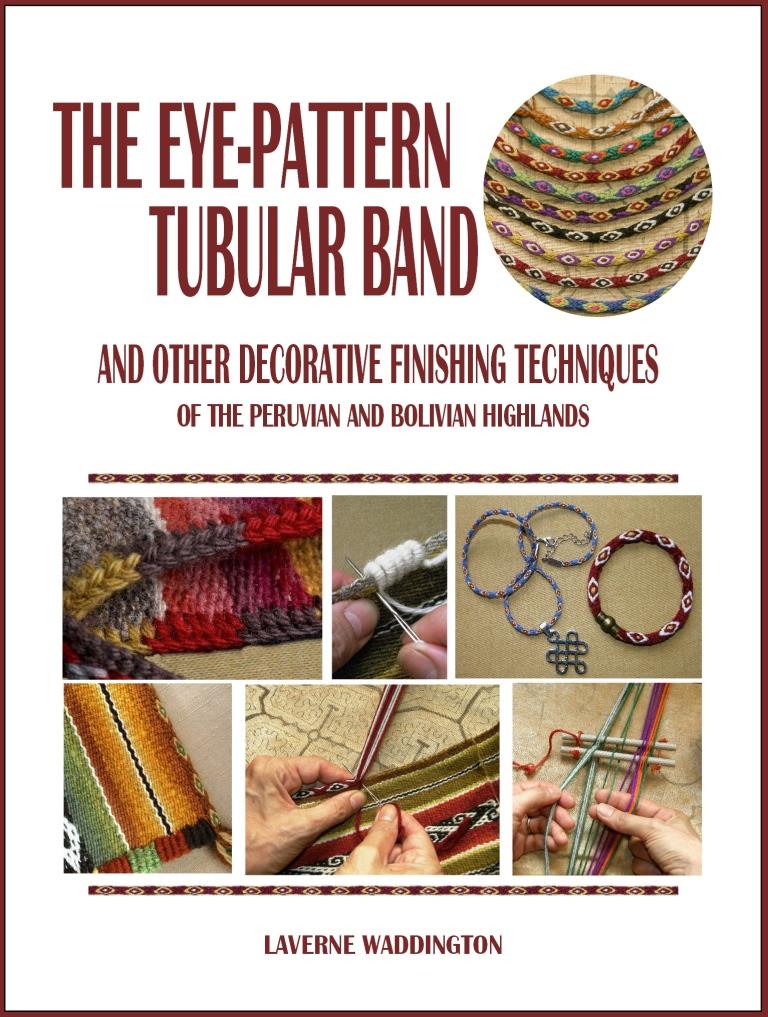




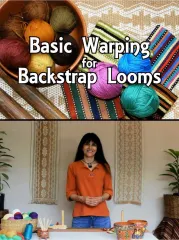







That little pouch is amazing!! Love the design on the inside of the flap. Spectacular job!
By: Jennifer on May 31, 2013
at 2:27 am
Thank you, Jennifer!
By: lavernewaddington on May 31, 2013
at 4:57 pm
Once again your finishing touches bring it all together! Your little bag is inspiring me to start a wider warp. I just finished my first 2 yard pebble weave backstrap sample and am ready for more.
By: Lausanne Allen on May 31, 2013
at 3:04 am
Wonderful discussion of the notion of ‘conventional’, Laverne. Indeed, one person’s normal is another’s far out and unheard of.
I’m struck by your comment that you’ve only scratched the surface of a few types of backstrap weaving. It’s truly an endless world.
I love your weaving in of the dowel. I’ve been trying to catch the Lao weavers as they conserve the warp in between projects. They have special sticks that are used to secure the warp to the loom bar, but I don’t know if they weave them in… will keep looking.
That two-sided pouch is precious! Your technical skills are amazing.
By: Tracy in Qatar on May 31, 2013
at 6:14 am
Thank you, Tracy. We are looking forward to hearing more about your discoveries in Laos. I say that I have only scratched the surface as the world of backstrap weaving in cotton in the lowlands is becoming increasingly into my view and calling to me. It is clear that backstrap weaving in the highlands of Bolivia, Peru, Chile and Ecuador is just one part of this very big picture. And then…I said ‘Latin America” which includes Mexico, of course…my hair stands on end thinking about all Mexican backstrap weavers are doing!
By: lavernewaddington on May 31, 2013
at 4:54 pm
Just when I think I’ve seen the most beautiful weaving you have ever done, you come up with another gorgeous piece. Love the weft faced piece and your finishing techniques.
Thanks for another lovely blog!
By: auntjanetsfiber on May 31, 2013
at 3:47 pm
Thanks, Janet! I am excited that we will be weaving together again soon 🙂
By: lavernewaddington on May 31, 2013
at 4:50 pm
The little temple is so cute! I would have never guessed. You work on the pouch is exquisite; I especially love the little tubular band.
By: Kristin on May 31, 2013
at 5:53 pm
Yes, that temple is adorable. They are the only backstrap weavers I have met so far that use one on such narrow pieces. Thanks for your comments on my pouch.
By: lavernewaddington on June 4, 2013
at 4:18 pm
Hooray for unconventional! Creative, inventive, inspired, visionary – other ways of saying “unconventional”. And how lucky we are to have such people among us! Placing surprise designs on the inside flap of the pouch qualifies as all of the above mentioned words! Just beautiful.
By: Julia on June 2, 2013
at 12:28 pm
Thank you, Julia :-)))))
By: lavernewaddington on June 4, 2013
at 4:19 pm
Fun reading, Laverne!
The pouches are stunning!
I love your experimentation and the fun “unconventional” ideas that lead to more ideas. You are ever contemplative and creative and I am ever in awe!
I am thinking of you as you head out once again for the States. We are so lucky to have you come visit. Looking forward to seeing you!
~Annie
By: Annie MacHale on June 3, 2013
at 2:10 pm
See you soon, Annie for our New Mexico adventure!
By: lavernewaddington on June 4, 2013
at 4:26 pm
wow, your little pouches are so lovely, it is amazing what you have learnt, and how delicious the pattern and colours are.
Are you manly self taught? It seems that there is no end of patterns, textures and materials one can use.Congratulations on a job well
By: Hilary Langley on June 11, 2013
at 1:35 am
Thank you. I have been studying with indigenous weavers in South America and Guatemala for 17 years. Learning this way about warp-faced structures has enabled me to recognize the techniques used by other weavers using simple looms in other countries around the world and create pieces based on their traditonal patterns and colors.
By: lavernewaddington on June 11, 2013
at 1:47 am
I am bowled over by how beautiful and ingenious this little pouch is. I’ve been off the grid with weaving for a while but as usual, all it takes is a bit of catching up with your blog for me to get out my strap and sticks and get back into the saddle again! Thanks for such an interesting post.
By: Jennifer on June 29, 2013
at 5:49 pm
Thanks Jennifer. I see your embroidery projects on Facebook and love them. I can imagine it must be hard for you to give that up for a while for backstrap weaving!
By: lavernewaddington on June 29, 2013
at 8:14 pm